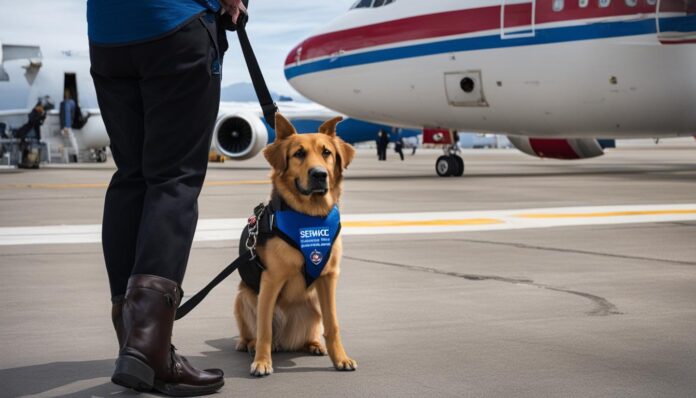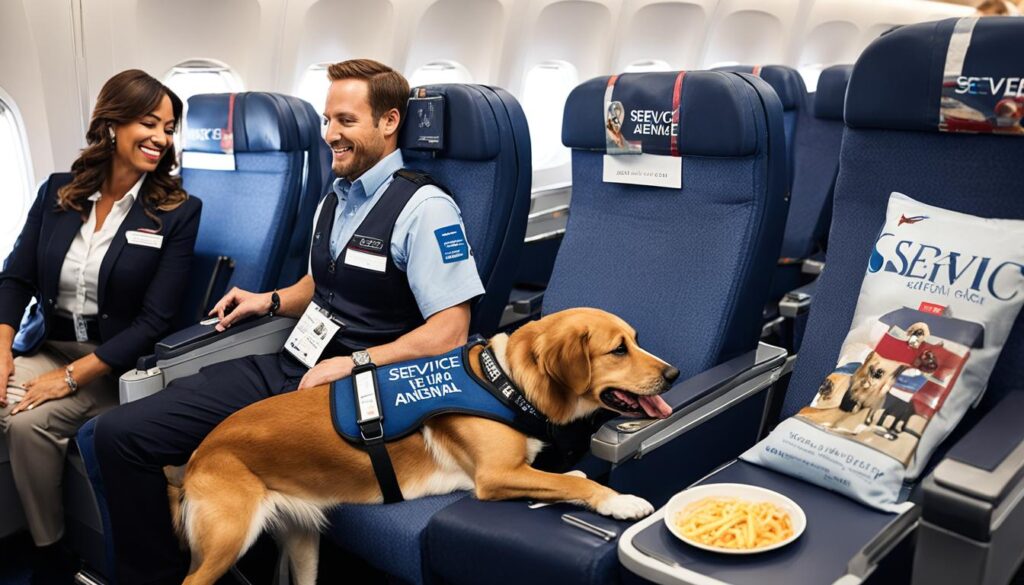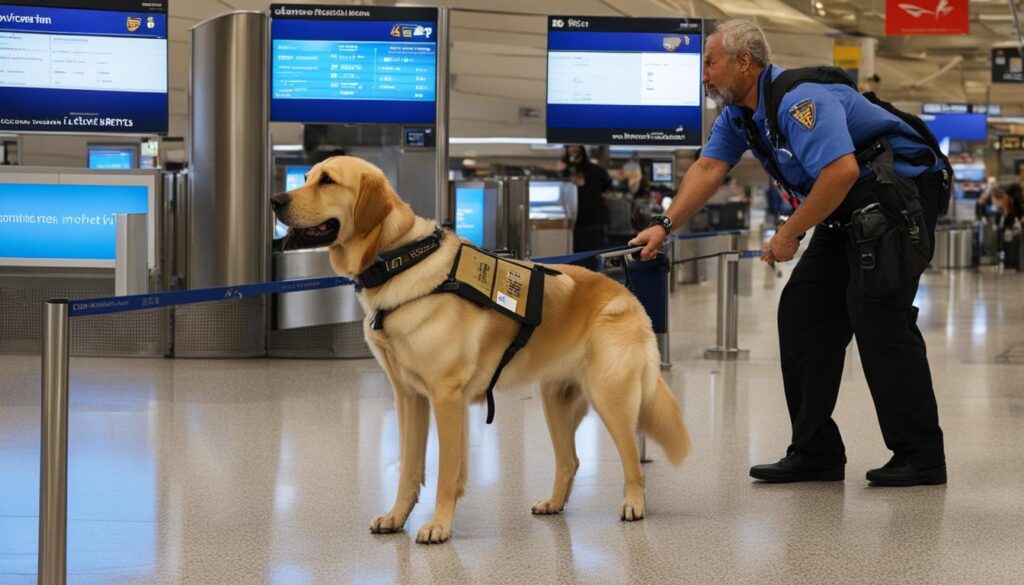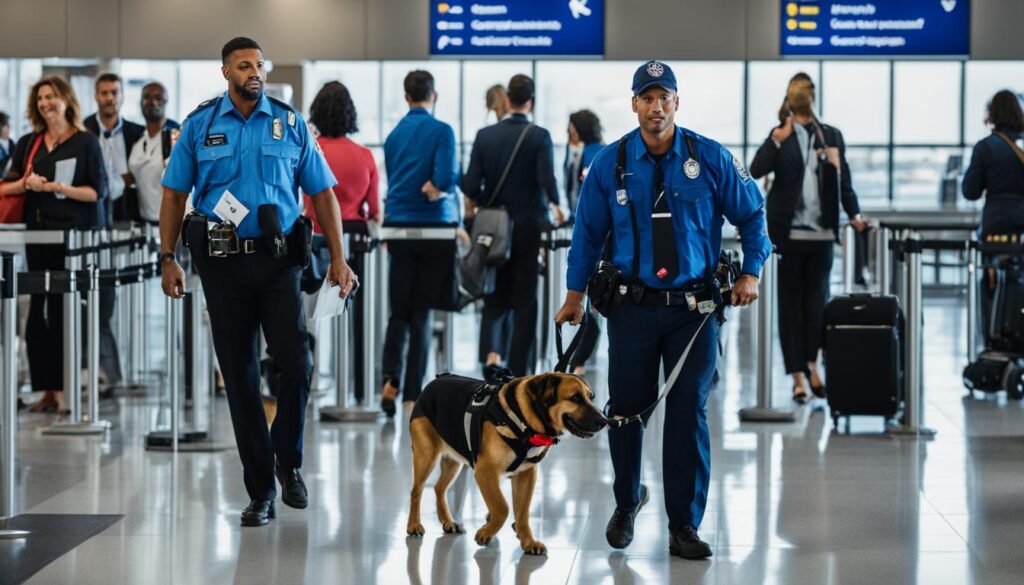Are you planning on traveling with your service animal? If so, it’s essential to understand the service animal travel guidelines to ensure a smooth and stress-free journey. As a service animal handler, you have specific rights and responsibilities when traveling, and it’s crucial to be aware of them to ensure you and your animal are treated fairly.
In this article, we will provide a comprehensive explanation of the latest service animal travel guidelines in the United States. We will discuss the rights of service animals and the rules that govern their access when traveling. By the end of this article, you will have a clear understanding of the guidelines for flying with a service animal and be prepared for your next trip
Let’s start with the basics – service animal access rights. According to the Americans with Disabilities Act (ADA), service animals are defined as dogs that are trained to do work or perform tasks for individuals with disabilities. Under the ADA, service animals must be allowed access to public places, including airlines, as long as they are under control and do not pose a threat to the health or safety of others.
However, it’s essential to note that other laws and regulations may also apply to service animal travel, and they may differ from state to state. Understanding the specific guidelines for your travel destination is crucial to avoiding any issues or conflicts when flying with your service animal.
Understanding Service Animals on Airplanes
When traveling with a service animal on an airplane, it’s essential to understand the specific regulations and policies set forth by airlines and regulatory bodies. These guidelines aim to ensure the safety and comfort of all passengers, including service animals and their handlers.
Firstly, airlines require documentation proving that your animal is a trained service animal, and not a pet. This documentation can take the form of a harness or vest, a doctor’s note, or other papers that verify your animal’s status. It’s always best to check with your airline in advance of your trip to understand the specific requirements for documentation.
In addition to documentation, behavior is another critical consideration for service animals on airplanes. Your animal should behave appropriately and calmly throughout the flight, following your instructions and not causing a disturbance to other passengers. If your animal displays disruptive or aggressive behavior, the airline may be within its rights to deny boarding or request that the animal remain in a carrier for the duration of the flight.
Other considerations for flying with a service animal on an airplane include seating arrangements and animal relief areas. Most airlines will allow service animals to sit with their handlers on the plane, either on the floor or in a seat next to them. However, it’s essential to verify with your airline to understand its specific seating regulations. Additionally, airlines are required to provide animal relief areas in each airport that they serve, so you can take your service animal to an appropriate area to relieve themselves during a layover or delay.
By understanding the policies and guidelines surrounding service animals on airplanes, you can ensure a smooth and stress-free journey for both you and your animal.
Service Animal Documentation Requirements for Travel
When it comes to traveling with a service animal, proper documentation is crucial to ensure smooth and stress-free travel. Let’s discuss the service animal documentation requirements and how to obtain travel permits for your furry friend.
| Document | Description |
|---|---|
| Service Animal Identification Card | This is an optional card that many service animal handlers carry to identify their animal and their specific tasks. While not required by law, it can be useful to have when traveling. |
| Doctor’s Note or Prescription | Many airlines and other travel providers require a doctor’s note or prescription for the service animal in order to approve travel. This note should indicate the handler’s need for a service animal and the animal’s tasks. |
| Vaccination Records | It’s important to have up-to-date vaccination records for your service animal before traveling. This can include proof of rabies, distemper, and other required vaccinations depending on your destination. |
In addition to the required documentation, some airlines and other travel providers may require a travel permit for service animals. This permit usually requires the same documentation as mentioned above and may include additional fees or forms to be filled out. It’s important to check with your specific travel provider for their requirements.
By ensuring you have the proper documentation and permits for your service animal, you can avoid potential travel disruptions and ensure a smooth journey for you and your furry friend.
Service Animal Training Requirements
Service animals are highly trained to assist their handlers with tasks such as navigating public spaces, alerting to medical emergencies, and responding to anxiety or panic attacks. To ensure their safe and effective assistance, service animals must meet specific training requirements under the Americans with Disabilities Act (ADA).
The training requirements for service animals comprise both behavioral and task-specific training. Behavioral training ensures that the service animal can interact appropriately with people and other animals and remain focused on its handler. Task-specific training includes teaching the animal tasks or commands that are directly related to the handler’s disability.
Examples of tasks that a service animal may be trained to perform include:
- Guiding individuals with visual impairments
- Alerting individuals with hearing impairments to sounds such as alarms or doorbells
- Retrieving medication or other items for individuals with mobility impairments
- Assisting individuals with psychiatric or neurological conditions by providing deep pressure therapy or interrupting self-harming or disassociative behavior
It’s important to note that service animals must be trained to perform tasks directly related to their handler’s disability. Emotional support animals, comfort animals, and therapy animals are not considered service animals under the ADA and do not have the same access rights as service animals.
If you are a handler of a service animal, it’s essential to ensure that your animal meets the training requirements and is certified as a service animal. This certification can be obtained from a reputable organization that specializes in service animal training and registration.
Service Animals in Airports: Navigating Access Rights
When traveling through airports with your service animal, it’s important to understand their access rights. Under the Americans with Disabilities Act, service animals are allowed access to all areas of an airport that are open to the public. However, it’s important to note that airports may have additional rules and guidelines for service animal access.
Airlines are required to make certain accommodations for service animals during pre-flight and post-flight procedures. This includes providing relief areas, water bowls, and allowing the service animal to remain with the handler at all times.
Guidelines for Service Animal Access
Airports may require documentation or identification for your service animal, so it’s important to have all necessary paperwork with you. Additionally, it’s good practice to contact your airline in advance to inform them that you will be traveling with a service animal.
| Airport | Service Animal Relief Areas | Guidelines and Restrictions |
|---|---|---|
| Los Angeles International Airport (LAX) | located inside and outside of each terminal building, pre-security | Service animals must be leashed and under control at all times. Handlers are responsible for cleaning up after their animals. |
| John F. Kennedy International Airport (JFK) | located inside and outside of each terminal building, pre-security | Service animals must be leashed or harnessed and under control at all times. Handlers are responsible for cleaning up after their animals. Relief areas may be used as pet relief areas for pets traveling in the cabin, but only service animals are allowed in the terminal. |
| Hartsfield-Jackson Atlanta International Airport (ATL) | located inside and outside of each terminal building, pre-security | Service animals must be leashed or harnessed and under control at all times. Handlers are responsible for cleaning up after their animals. Relief areas may be used as pet relief areas for pets traveling in the cabin, but only service animals are allowed in the terminal. |
It’s important to remember that service animals are working animals, and as such, should be treated with respect and allowed to perform their tasks without distraction. By complying with airport guidelines and understanding your service animal’s access rights, you can ensure a smooth and stress-free travel experience for both you and your animal.
Service Animal Travel Laws: Federal and State Regulations
As a service animal handler, it’s important to be aware of the federal and state laws that govern service animal travel. These regulations are in place to ensure the safety and well-being of all passengers, including service animals and their handlers.
The Americans with Disabilities Act (ADA) is a federal law that guarantees service animal access rights in public places, including airports and airplanes. However, individual states may have additional laws that supplement or expand upon the ADA regulations.
For example, some states may have stricter requirements for service animal documentation or training than the ADA mandates. Additionally, there may be limitations on the types of animals that qualify as service animals under state laws.
It’s important to research the specific laws and regulations in both your departing state and your destination state to ensure compliance. Failure to follow these laws can result in denied access to transportation or other legal consequences.
Be sure to check with the airline you’ll be traveling with to understand any additional policies or requirements for service animal travel. Some airlines may require advance notification or documentation, and you’ll want to be fully prepared before your trip.
Ensuring a Stress-Free Journey with Your Service Animal
Traveling with a service animal can be a smooth and stress-free experience if you are aware of the policies and precautions necessary to ensure a safe and comfortable journey. Here are some practical tips to help you prepare for your next flight:
Prepare in Advance
Communicate with your airline beforehand to ensure they are aware of your service animal and any special accommodations they may require. Review the airline’s service animal policies so that you are fully aware of their requirements and any restrictions.
Documentation Requirements
Make sure to bring up-to-date documentation for your service animal including vaccination records, health certificates, and any necessary permits. These documents will help ensure a hassle-free check-in process and minimize any travel-related complications.
Behavior Training
Ensure that your service animal is well-trained and able to handle the travel environment, such as loud noises and crowded spaces. Make sure they are comfortable traveling in a carrier or crate if required by the airline. Proper planning and preparation can make a big difference in your service animal’s safety and comfort during travel.
In-Flight Considerations
During the flight, service animals are typically required to remain under your control and not take up any additional space. If your service animal requires medications or special attention, make sure to bring them with you. It is also a good idea to bring extra supplies such as food, water, and waste disposal bags to ensure your service animal’s needs are fully met.
Recognizing Fake Service Animals: The Impact on Legitimate Users
One of the biggest challenges facing service animal users is the rise of fake service animals in public spaces. A fake service animal is a pet that is misrepresented as a service animal by its owner, often to gain access to places where pets are typically not allowed, such as airplanes, restaurants, and stores. This practice not only violates service animal policies but also adversely affects legitimate service animal users.
Fake service animals can jeopardize the safety and well-being of other service animals and their handlers. They can cause distractions, act aggressively towards other animals, and interfere with the work of legitimate service animals. Moreover, the rising number of fake service animals has led to increased scrutiny of legitimate service animals, resulting in greater access restrictions, and even denial of access to places where service animals are legally permitted.
The consequences of misrepresenting pets as service animals can be severe. It is a violation of federal law and can result in fines and imprisonment. Additionally, fake service animals can cause a poor reputation for service animals and their handlers, who may face harassment and discrimination due to the bad behavior of fake service animals.
Thus, recognizing fake service animals and reporting them to authorities is crucial to uphold the integrity of service animal access rights and ensure a safe and comfortable experience for legitimate users. Look for signs of fake service animals, such as aggressive behavior, lack of training, and inappropriate attire. You can also ask for documentation or evidence of certification, as legitimate service animals always have proper documentation and identification. By working together to identify and report fake service animals, we can protect the rights of legitimate service animal users and ensure the safety and well-being of all.
Advocating for Service Animal Travel Rights
Ensuring service animal access rights and advocacy for their wellbeing is an ongoing effort that requires collective action. Both federal and state laws protect the rights of service animals, but it is crucial to stay informed and involved in initiatives seeking to improve and expand these protections.
In recent years, several organizations have emerged to provide support and guidance to service animal handlers, including the National Service Animal Registry (NSAR), the United States Service Dog Registry (USSDR), and Canine Companions for Independence. These organizations aim to educate the public and policymakers about the vital role of service animals and promote the implementation of fair and effective policies.
Additionally, it is essential to report any incidents of discrimination against service animals or their handlers. You can file a complaint with the Department of Transportation (DOT) or the Americans with Disabilities Act (ADA) National Network, who are responsible for investigating and resolving any claims of discrimination.
By advocating for service animal travel rights, you play a crucial role in promoting inclusivity and accessibility for all individuals. Together, we can ensure that service animals and their handlers receive the respect and accommodations they deserve.
Conclusion
In conclusion, understanding the service animal travel guidelines in the United States is crucial for a stress-free and enjoyable journey with your service animal. By following the regulations and policies related to service animals on airplanes, ensuring you have the required documentation and permits, and adhering to the training requirements for service animals, you can ensure a safe and effective travel experience.
It is also important to understand the access rights of service animals in airports and advocate for the integrity of these rights and the wellbeing of service animals and their handlers. By preparing for your journey, communicating with airlines, and recognizing the impact of fake service animals on legitimate users, you can ensure a smooth travel experience for you and your service animal.
Remember to stay informed about any updates or changes to service animal travel laws and always prioritize the safety and comfort of your service animal. With these guidelines in mind, you can ensure a successful journey and enjoy the many benefits of traveling with your loyal companion by your side.

















































